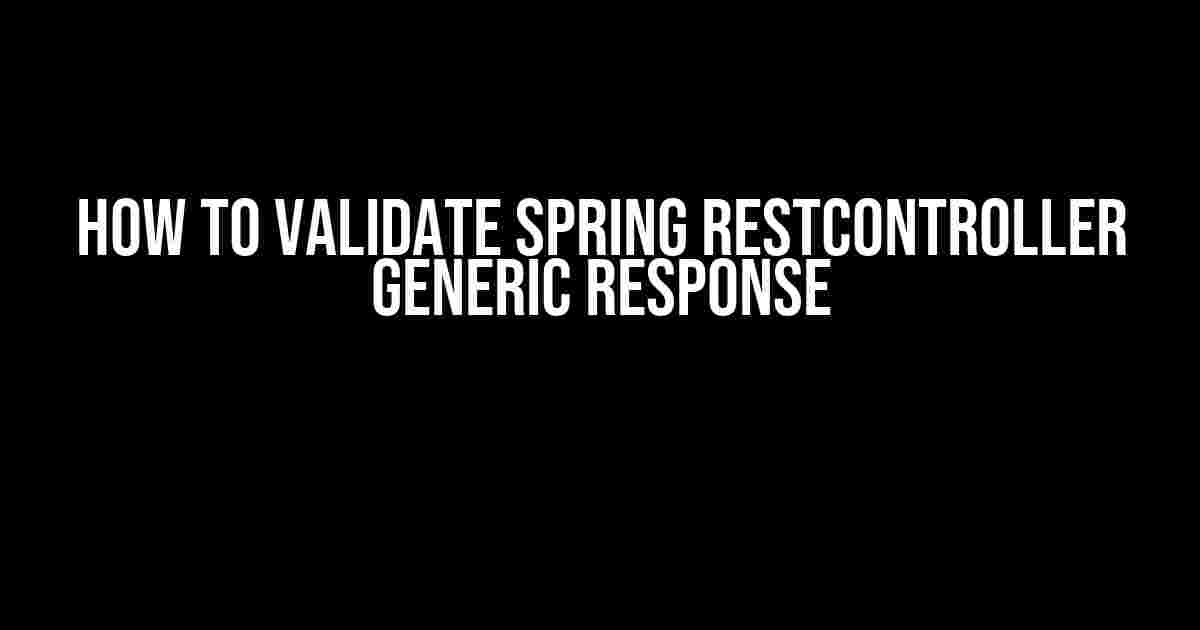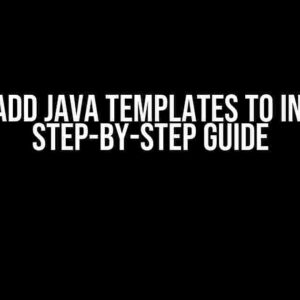Hey there, fellow developers! Are you tired of wrestling with Spring RestController responses, trying to figure out how to validate them? Well, you’re in luck because today we’re going to dive deep into the world of generic responses and explore the best ways to validate them. So, grab your favorite beverage, sit back, and let’s get started!
What is a Generic Response?
Before we dive into validation, let’s quickly cover what a generic response is. In Spring, a generic response is a response object that can be returned by a controller method. It’s a way to standardize responses across your API, making it easier for clients to understand and consume the data. A generic response typically includes metadata, such as status codes, error messages, and data.
Why Validate Generic Responses?
Validating generic responses is crucial for several reasons:
- Improved Error Handling**: Validating responses helps you catch errors and exceptions early on, reducing the chances of errors propagating to the client-side.
- Better API Quality**: Validation ensures that your API returns consistent and predictable responses, making it easier for clients to integrate with your API.
- Enhanced Security**: By validating responses, you can prevent potential security vulnerabilities, such as data leakage or unauthorized access.
How to Validate Spring RestController Generic Response
Now that we’ve covered the why, let’s move on to the how. There are several ways to validate generic responses in Spring, and we’ll explore the most common approaches.
1. Using @Valid Annotation
The @Valid annotation is a built-in Spring annotation that allows you to validate objects using a Validator implementation. To use @Valid, you need to:
- Add the @Valid annotation to the response object:
@RestController
public class MyController {
@GetMapping("/users")
public ResponseEntity<GenericResponse<User>> getUsers() {
GenericResponse<User> response = new GenericResponse<>();
response.setData(Arrays.asList(new User()));
return ResponseEntity.ok(response);
}
}
public class GenericResponse<T> {
@Valid
private T data;
// getters and setters
}- Implement a Validator for the response object:
@Component
public class GenericResponseValidator implements Validator {
@Override
public boolean supports(Class<?> clazz) {
return GenericResponse.class.isAssignableFrom(clazz);
}
@Override
public void validate(Object target, Errors errors) {
GenericResponse<> response = (GenericResponse<>) target;
// perform validation logic here
}
}2. Using JSR-303 Bean Validation
JSR-303 Bean Validation is a specification for validating Java beans. To use JSR-303, you need to:
- Add the @Valid annotation to the response object:
@RestController
public class MyController {
@GetMapping("/users")
public ResponseEntity<GenericResponse<User>> getUsers() {
GenericResponse<User> response = new GenericResponse<>();
response.setData(Arrays.asList(new User()));
return ResponseEntity.ok(response);
}
}
public class GenericResponse<T> {
@Valid
private T data;
// getters and setters
}- Define validation constraints using JSR-303 annotations:
public class User {
@NotEmpty
private String name;
@Email
private String email;
// getters and setters
}3. Using Custom Validation Logic
If you need more fine-grained control over validation, you can implement custom validation logic using Java code. For example:
@RestController
public class MyController {
@GetMapping("/users")
public ResponseEntity<GenericResponse<User>> getUsers() {
GenericResponse<User> response = new GenericResponse<>();
response.setData(Arrays.asList(new User()));
validateResponse(response);
return ResponseEntity.ok(response);
}
private void validateResponse(GenericResponse<User> response) {
if (response.getData() == null || response.getData().isEmpty()) {
throw new ResponseValidationException("Response data is empty");
}
for (User user : response.getData()) {
if (StringUtils.isEmpty(user.getName())) {
throw new ResponseValidationException("User name is empty");
}
}
}
}Best Practices for Validating Generic Responses
When validating generic responses, keep the following best practices in mind:
- Keep it simple**: Avoid complex validation logic that can lead to maintenance headaches.
- Be consistent**: Use a consistent validation approach throughout your API to ensure consistency and predictability.
- Handle errors gracefully**: Catch and handle validation exceptions gracefully to prevent errors from propagating to the client-side.
- Document validation rules**: Document your validation rules and constraints to ensure that clients understand the expectations.
Conclusion
Validating Spring RestController generic responses is a crucial step in building robust and reliable APIs. By using one of the approaches outlined in this article, you can ensure that your responses are consistent, predictable, and error-free. Remember to keep your validation logic simple, consistent, and well-documented, and don’t hesitate to reach out if you have any questions or need further guidance.
| Approach | Description |
|---|---|
| @Valid Annotation | Uses Spring’s built-in @Valid annotation to validate objects |
| JSR-303 Bean Validation | Uses JSR-303 annotations to define validation constraints |
| Custom Validation Logic | Implements custom validation logic using Java code |
Happy coding, and don’t forget to validate those responses!
Frequently Asked Question
Get ready to unlock the secrets of validating Spring RestController generic responses! Here are the top 5 questions and answers to get you started:
What is a generic response in Spring RestController?
A generic response in Spring RestController refers to a response object that can be used to return data from a RESTful API. This response object can be customized to include information such as status codes, error messages, and data.
Why do I need to validate a generic response in Spring RestController?
Validating a generic response is crucial to ensure that the data returned from the API is correct and meets the expected format. This helps to prevent errors, improve data quality, and enhance the overall user experience.
How can I validate a generic response using Spring’s @Valid annotation?
You can use Spring’s @Valid annotation to validate a generic response. Simply add the @Valid annotation to the response object, and Spring will automatically validate it against the constraints defined in the object. For example, @Valid ResponseObject responseBody.
Can I use a custom validator to validate a generic response?
Yes, you can use a custom validator to validate a generic response. Spring provides the @InitBinder annotation, which allows you to define a custom validator for a specific object. You can also use the @Validated annotation to enable validation for a specific class.
What are some best practices for validating generic responses in Spring RestController?
Some best practices for validating generic responses in Spring RestController include using @Valid annotation, defining custom validators, using Bean Validation API, and implementing error handling mechanisms to handle validation errors.



